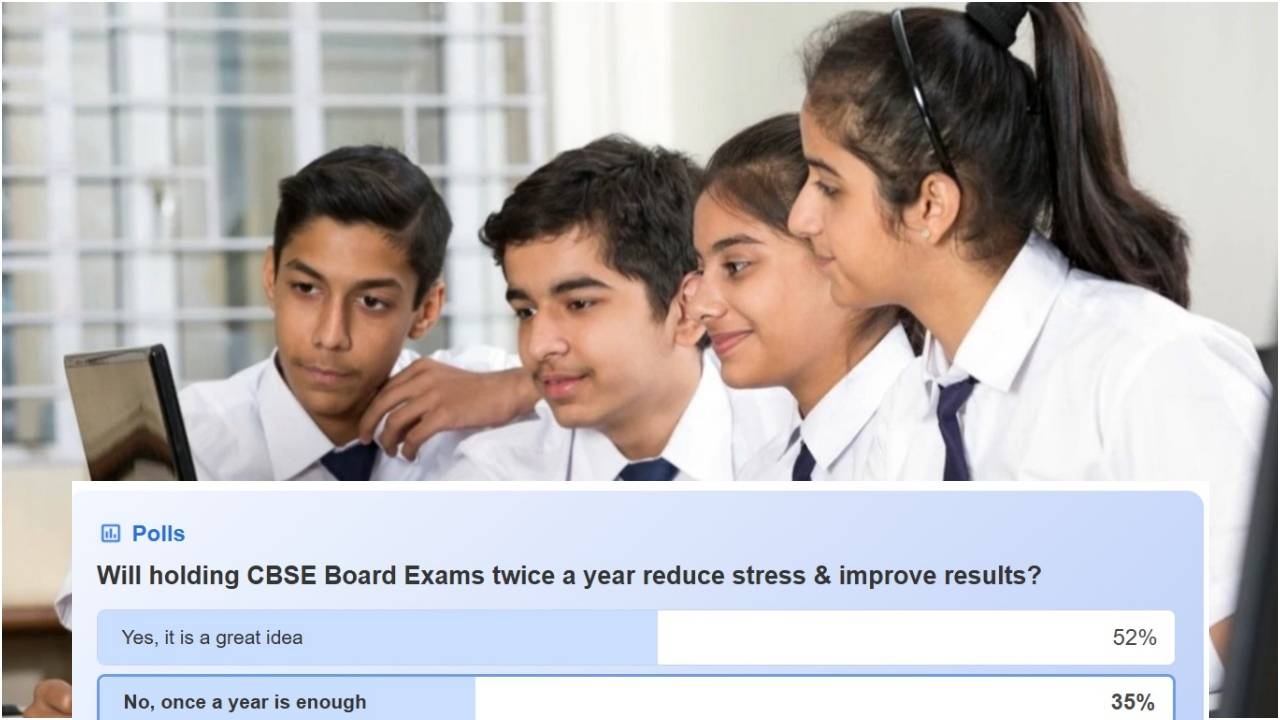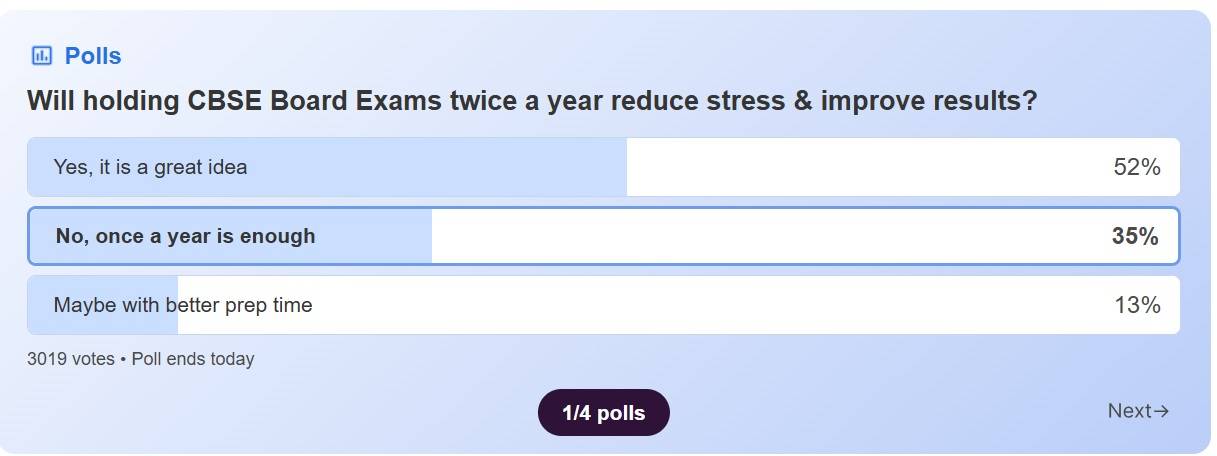Shiksha Poll: 52% says CBSE 10th Board Exam 2026 Twice will improve results & reduce stress
CBSE Board Exam 2026 Class 10 Twice proposal aims to reduce stress, improve flexibility, and provide students with more opportunities to perform well. However, it also presents challenges in implementation and adjustments for schools, students, and parents alike. A recent Poll conducted by Shiksha.com on CBSE 10th Board Exam twice revealed that 13% stakeholders want better preparation time between the two phases.
CBSE 10th Board Exam 2026 Twice: The Central Board of Secondary Education (CBSE) has unveiled a draft proposal for significant changes to the Class 10 Board Exam 2026, including the introduction of a Twice-A-Year Examination System. This new structure aims to reduce stress, improve flexibility, and provide students with more opportunities to perform well. However, it also presents challenges in implementation and adjustments for schools, students, and parents alike.
- CBSE Board Exam 2026 Twice-A-Year
- Poll Results: Public Opinion on CBSE 10th Exam Twice-A-Year
- Syllabus, Subjects, and Groupings: A Detailed Structure
- Advantages and Challenges of conducting CBSE Board Exam 2026 Twice
- Results and Merit Certificates
- Examination Process and Internal Assessments
- Challenges in Implementation
- Stakeholder Feedback and Final Draft
CBSE Board Exam 2026 Twice-A-Year
In what could be a transformative shift in the CBSE examination system, the Class 10 Board Exams for 2026 will be held in two phases:
- First Phase: February 17 to March 6, 2026
- Second Phase: May 5 to May 20, 2026
The exams will be conducted in two shifts, with approximately 26.60 lakh students expected to appear. The proposal has received mixed reactions, as the two-exam system offers both flexibility and additional stress for students.
Students can check the CBSE result 2026 on the official websites- results.cbse.nic.in, cbse.gov.in, cbse.nic.in. They will need to enter their roll number and other details as mentioned in the CBSE admit card 2026 to check their result.
CBSE is expected to release the CBSE 12th result 2026 in the second week of May 2026. Check the important dates related to the 12th board exams below:
| Question | Answer |
|---|---|
| When will CBSE 12th Result 2026 be released? | The CBSE 12th Result 2026 will be out in the second week of May 2026. |
| Can I use a scientific calculator in the CBSE 12th board exams 2026? | NO. No type of calculators, mobile phones, or any technological gadget is allowed during CBSE exams. Any student caught carrying these will be barred from writing their exam. |
| When will CBSE 12th compartment result 2026 be released? | Central Board of Secondary Education is expected to release the CBSE 12th compartment result 2026 in August 2026. |
Note: The above information is based on the previous year's trends and is subject to change as per the board's discretion.
Poll Results: Public Opinion on CBSE 10th Exam Twice-A-Year
To gauge public opinion, Shiksha.com conducted a poll asking, “Will holding CBSE Board Exams twice a year reduce stress & improve results?” Over 3,000 stakeholders participated, and the results were as follows:
- 52%: Respondents agreed that conducting exams twice a year is a great idea.
- 35%: Believed that conducting exams once a year was sufficient.
- 13%: Felt that having two exams could be beneficial but only if students had better preparation time.
These results suggest that the majority of participants are in favor of CBSE Board Exam 2026 Class 10 twice a year, although there are concerns about the potential for increased stress.
Syllabus, Subjects, and Groupings: A Detailed Structure
The exams will be based on the full syllabus prescribed for CBSE Class 10. The examination will follow the existing pattern with the core subjects held on fixed days, including:
- Group 1: Core subjects like English, Maths, Science, and Social Science.
- Group 2: Regional languages, Foreign languages, and elective subjects.
- Group 3: Vocational and skill-based subjects like Data Science, IT, and Marketing.
Additionally, subjects like Regional Languages and Foreign Languages will be grouped for a single day of examination, while vocational subjects will have separate dates.
Advantages and Challenges of conducting CBSE Board Exam 2026 Twice
Dr. Satyabrata Minaketan, Chairman of the ODM Educational Group, commented on the proposed changes, acknowledging that the bi-annual exam system could be beneficial by providing students a second chance to improve their results. However, he warned about potential challenges.
CBSE is expected to release the CBSE Class 12 result 2026 in the first week of May 2026 on the official website- cbse.gov.in. Phase 1 result of CBSE Class 10 exam 2026 shall be out in April 2026 while CBSE exam Class 10 result 2026 for Phase 2 will be released in June 2026.
Students can check their CBSE Result 2026 using their admit card roll no, DOB, the center, and school number. Students can also check their CBSE 10th, 12th Result 2026 through SMS, Call or IVRS, UMANG App and DigiLocker. The CBSE 10th Result 2026 is also released on the newly launched examination portal 'Pariksha Sangam'.
The passing criteria for CBSE board exams state that a student must secure an overall 33% (including internal assessment and Board examination) in all the subjects.
The CBSE result 2026 released online is provisional. Students need to collect the original mark sheet from their school.
"Giving students a second chance through bi-annual board exams is a well-intentioned move, but it comes with challenges. While it may ease pressure and align with global education systems, the constant exam cycle could create unnecessary stress. Students already juggle entrance exams like JEE, NEET, and CUET—adding another test in the middle of it all might do more harm than good," he stated.
On the positive side, Praneet Mungali, Trustee and Secretary of Sanskriti Group of Schools, highlighted how the change aligns with the National Education Policy (NEP) 2020, emphasizing flexibility. He noted that this system could benefit students who may face unexpected challenges like illness, giving them a chance to attempt the exams again. However, Mungali also expressed concern about the additional pressure on students, particularly if they feel compelled to sit both exams in hopes of improving their scores.
“The recent announcement to conduct board exams twice starting from 2026. This decision aligns with the vision set forth by the National Education Policy (NEP) 2020, which emphasises flexibility and a student centric approach. This essentially means that students can improve on their score in the second board exam, and the best score will be considered as the official score. This change is certainly advantageous for students, wherein their board marks are not determined by a single exam in case they are sick, or underprepared due to any exigency,” Mungali said.
He further added, “However, there is a challenge for students. Students will feel the pressure to give both the exams, with the hope to achieve a higher grade in the next exam. This will mean that students will continue to study through their regular school year, and into the summer vacations. This will prolong the stress students experience. It would be ideal if the second round of exams are only available to students who score below a certain threshold. This would be beneficial for students, since Grade 10 marks are anyway only a precursor for subject choice in grade 12 and do not play a huge role later in the student’s career.”
Results and Merit Certificates
A key element of the new system is the improvement opportunity. Students will receive the best score from either phase, ensuring that their final marks reflect their best performance. After the second examination, students will receive their passing certificates and merit certificates. The results for both phases will be available through DigiLocker.
Examination Process and Internal Assessments
The exam procedure will also include no special exams—students who miss the first exam will be able to sit for the second one. Both phases will require internal assessments and practical exams, but these will only be conducted once and will remain valid for both attempts.
Additionally, the List of Candidates (LOC) for the first phase will need to be submitted by September of the previous year. Once the LOC is submitted, students will not be allowed to change subjects before the first exam.
Challenges in Implementation
While the proposal offers greater flexibility, there are logistical challenges to consider. Schools will be evaluated on their ability to serve as examination centers, and adjustments to the existing exam bye-laws will be necessary. Moreover, the increased frequency of exams will place a heavy workload on teachers, students, and the educational system as a whole.
Stakeholder Feedback and Final Draft
The proposed changes are still in the draft stage, with the CBSE requesting feedback from stakeholders—teachers, students, parents, and school authorities—by March 9. The feedback will be reviewed, and a final draft will be released for the 2026 CBSE Class 10 Board Exams, incorporating the suggestions and concerns raised during this consultation period.
As the system evolves, it is clear that the CBSE’s Twice-A-Year Exam System represents a significant shift aimed at improving student well-being and performance. Whether this change will be effective in reducing stress and enhancing results remains to be seen, but it opens a new chapter in the future of India’s educational landscape.
Read More:

Comments
(1)
G
8 months ago


Central Board of Secondary Education (CBSE) released the CBSE 10th supplementary result 2025 on August 5, 2025. The result is released on the official website- cbse.nic.in. Students can check their CBSE compartment result 2025 using their login credentials as mentioned in the CBSE 10th admit card 2025 for compartment exams. It should be noted that the CBSE compartment result 2025 class 10 released online is provisional in nature. Students will need to collect the original mark sheet from their schools respectively.